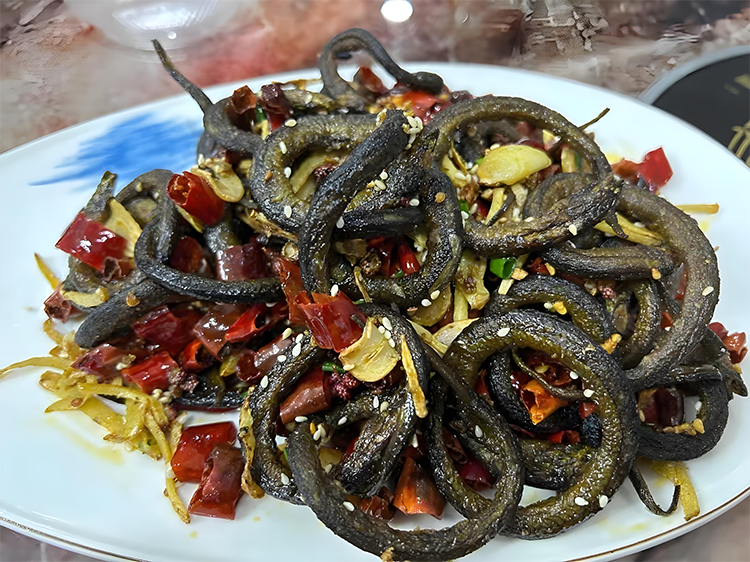Ningbo Braised Eel: Pan-Fragrant Eel of Zhejiang
1. Origins on the East China Sea Coast: A dish through time
Pan-fragrant braised eel is closely tied to Ningbo’s long history as a major port. As a key origin point of the Maritime Silk Road, Ningbo was rich in seafood. Local fishermen developed this special preparation to preserve and enjoy the eel (commonly called shanyu locally). Its earliest forms go back to the Ming and Qing dynasties: deboned eels were coiled into a disk, fried to hold shape, and then slowly braised. This technique extended shelf life and unexpectedly created a pleasing contrast between a crisp exterior and tender interior, elevating a humble fishermen’s dish to a celebrated banquet centerpiece.
2. Cultural symbol: What does “pan-fragrant” mean?
“Pan-fragrant” (pan xiang) refers to the eel’s coiled, plate-shaped presentation. In Chinese culture, the circular form symbolizes reunion, completeness, and harmony, so this dish often appears at family gatherings and important banquets to express wishes for togetherness and prosperity. Its glossy red-brown finish also conveys auspicious, festive sentiments. Through this plate, you can sense Ningbo’s pragmatic yet refined coastal lifestyle.

3. Ingredients: Sea essence meets local pantry
Authentic pan-fragrant eel begins with fresh wild eel from the East China Sea—firm, rich, and mild in fishiness. Supporting ingredients reflect Zhejiang cuisine’s aim to enhance natural flavors: good soy sauce, Shaoxing (yellow) wine, ginger, garlic, sugar, and aromatic vinegar are essential. Local Ningbo soy and Shaoxing wine lend a deep, rounded aroma that complements the eel’s natural sweetness, producing the dish’s balanced sweet-salty-savoury profile.
4. Craftsmanship: From live fish to a savory centerpiece
The cooking demands patience and skill, typically in three stages:
Deboning and shaping: The live eel is cleaned and carefully deboned while keeping the meat intact. The boneless flesh is then coiled meat-side-out into a tight, flat disk, resembling a burning incense coil.
Frying to seal: The coiled eel is gently fried in hot oil over medium heat to set the shape, create a crisp crust, and lock in juices.
Braising to flavor: With a little oil left in the pan, ginger and garlic are scented, the fried eel is added, and Shaoxing wine, soy sauce, sugar, and water are poured in. Simmer slowly until the sauce reduces and coats the eel, then finish with a splash of fragrant vinegar and a quick high heat reduction to awaken the layered aromas.

5. A symphony of flavors: Crunch, sweetness, and savory depth
When served hot, the dish first seduces by sight and smell: glossy red-brown lacquer, soy aroma, the mellow scent of Shaoxing wine, and the toasty notes from frying. The first bite reveals an irresistible crisp outer layer, followed by tender, slightly springy eel meat. The flavor evolves from savory and umami to a gentle sweetness typical of Zhejiang cooking, finishing with a light tang of vinegar that cleanses the palate and leaves a lingering aftertaste.
6. How to enjoy it authentically
In Ningbo, pan-fragrant eel is usually a main course at banquet tables. Two genuine ways to enjoy it: taste it directly to appreciate the complex layers, or pair it with steamed white rice—mixing the thick, sweet-savory sauce into rice makes every grain rich and satisfying. Because the dish is richly flavored, balance it with a light vegetable soup or steamed greens. A warmed cup of Shaoxing wine alongside enhances authenticity and aroma.

7. Traveler’s tasting tips: Where to eat and how to order
For visitors seeking the most authentic pan-fragrant eel, go to long-established local restaurants or busy seafood stalls frequented by residents—areas around Ningbo’s Chenghuang Temple and Baisha Wharf are good bets.
Ordering tips: Eel is often prepared to order and takes time, so reserve ahead or be prepared to wait. Ask for “pan-fragrant eel” or say the dish name in Chinese: (pan xiang shan yu). If priced by weight, ask staff for a recommended portion.
Travel suggestion: Combine a tasting with visits to Ningbo’s Old Bund, Tianyi Pavilion, or Moon Lake in the same day—savor local history, then let food complete the experience.
8. Home-friendly version: A simplified recipe
You can recreate a simplified home version away from Ningbo:
Ingredients: pre-cut eel or large fish fillets, ginger, garlic, scallion; soy sauce, dark soy (for color), Shaoxing or cooking wine, sugar, and vinegar.
Steps:
- Pat fish dry; pan-fry or shallow-fry until golden on both sides.
- Remove some oil, sauté ginger and garlic, add the fried fish.
- Add Shaoxing wine, soy sauces, sugar, and hot water (covering half the fish).
- Simmer covered for 10–15 minutes on low heat.
- Uncover and reduce on high heat until sauce thickens; finish with a dash of vinegar.
Though not coiled, this version preserves the savory-sweet, slightly tangy taste that makes pan-fragrant eel so addictive.

9. Conclusion: Bite into Ningbo’s memory
Pan-fragrant braised eel is a flavor crafted by time and skill. Born from the East China Sea and perfected in Ningbo kitchens, it blends maritime boldness with Jiangnan refinement. Each crunchy bite and sweet-salty note tells a chapter of the city’s story. When planning your next trip to China, include Ningbo on your list to taste this memorable regional specialty—more than a dish, it’s a cultural and culinary experience waiting to be unlocked.


